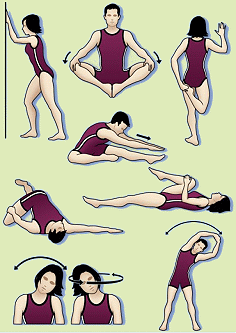Physical Exercise

Physical exercise is any bodily activity that enhances or maintains physical fitness and overall health and wellness. It is performed for various reasons including strengthening muscles and the cardiovascular system, weight loss, improves mental health, helps prevent depression, helps to promote or maintain positive self-esteem, and can even augment an individual’s sex appeal or body image. Regular physical exercise also boosts the immune system, and helps prevent heart disease, cardiovascular disease, Type 2 diabetes and obesity.
Strength training is for those individuals who wish to improve their overall health and fitness levels. Strength training (also called resistance training) has been verified to improve bone density, raise metabolism, contribute to heart health and fight obesity. Those engaged in strength training, strive to reduce body fat and tone muscle groups to attain a general improvement in physical appearance while benefiting from achieving optimum health. While many of these individuals use strength training for muscle tone and weight management, it is very different from body building where the focus is on muscle mass.
The exercise programs of individuals that employ strength training can vary widely. Some favour a similar approach to weight lifting (like body builders), using heavy weights and lower repetitions, others stick to lower weights and higher reps. Increasing repetitions does have its place in an exercise program as it helps improve muscular endurance. Variations in types of strength training, such as circuit training, are also options.
Those engaged in body building, strive to reduce body fat and build up muscle groups to attain an extensive improvement in physical appearance while also benefiting from achieving optimum health. Body building incorporates strength training, and following a diet that contributes chiefly to muscle growth for the purpose of building muscle mass. Body builder’s focus on consuming ideal ratios of different macro-nutrients (particularly protein for muscle growth and recovery) in order to best accomplish their goals. These individuals usually enlist the routine of heavy weight and lower repetitions to achieve the desired results.
Advantage
Lifestyle changes see many of us ‘sitting’ for long periods of time during the day, every day. Our muscles inadvertently pay the price - The stiffness of joints and the weakening of muscles that we sometimes blame on ageing are often a direct effect of inactivity.
Making an effort to tone your muscles will most certainly strengthen your muscles. Strong muscles improve your physical appearance and may help avoid potentially debilitating bone and joint injuries. Doing strength training exercises can increase your lean body mass, which naturally raises your metabolic rate, resulting in weight management. (A kilo of muscle will burn 50 to 100 calories a day at rest, whereas a kilo of fat will use up only about 5 to 7 calories a day).
Strength Training Exercises
Strength training exercises work your muscles by applying a resistance against which the muscles are required to exert force. The aim is to use an appropriate weight or resistant force that will work the targeted muscles to fatigue, over 8 to 12 repetitions of an exercise. A typical strength training program involves 8 to 12 exercises that work the major muscle groups of the body. These exercises are usually performed two or three times every week.
A pair of hand-weights (or 2 bags of rice) supply the resistance required in these exercises. When first starting out, the weight of your own body can even be used as the resistance against which the muscles are required to work. Expensive or elaborate gym equipment, although it can be used, is not required to undertake a strength training program - You can accomplish this at home with minimal equipment, and no gym membership required!
You will gain the most benefit from three strength training sessions a week. However, two sessions will still give very good results providing you are focused and strict with your routine and form. Persisting with your strength training routine is the key to escalating your fitness level and achieving your desired physical appearance. By rapidly increasing the intensity of the exercises, or by rapidly reducing the time you spend doing them, can lead to injury and therefore total abandonment of the routine.
Strength training must not be done on consecutive days unless different muscle groups are worked (e.g. arms on Monday, legs on Tuesday). This is because muscle tissue is broken down during strength training, and recovery time is required for the tissue to repair or rebuild - This is how the muscles strengthen and tone.
Warm Up and Stretch Before beginning strength training exercises, you need to warm up. This means two to three minutes of jogging or skipping, or three to five minutes of riding an exercise bike. The aim is to increase your heart rate and blood flow to your muscles, to warm the muscle tissues to make them more pliable - A simple measure to help prevent injury during exercise.
Before beginning strength training exercises, you need to warm up. This means two to three minutes of jogging or skipping, or three to five minutes of riding an exercise bike. The aim is to increase your heart rate and blood flow to your muscles, to warm the muscle tissues to make them more pliable - A simple measure to help prevent injury during exercise.
Follow your warm-up with a short five minute stretching routine, again as a means of priming your muscles. Make sure you gently stretch each of the muscles that you will be working with the strength training exercises - While stretching the muscles in your back, abdomen, chest, shoulders, arms and legs, hold each stretch for about 10 seconds.
Immediately after your set of strength training exercises you should stretch the muscle group you have just used, - Before moving on to the next exercise. The muscles will be warm and flexible at this time. For example, after a set of 12 reps of biceps curls, stretch your biceps muscle before moving on to a triceps strength training exercise.
Cooling Down
Equally important is cooling down after your strength training exercises. This can involve easy walking or cycling for two to three minutes, followed by five to ten minutes of stretching. The aim is to: Remove waste products from your muscle tissue, prevent blood pooling in the lower half of your body, and to help prepare your body for the next strength training session in two or three day’s time.
Strength Training Routine
Always exercise the largest muscle groups first, such as your hips and upper legs, then move to your lower legs, upper torso, arms, abdominal and lower back.
The abdominal and back muscles are stabilising muscles that help you to maintain correct form and should be exercised at the end of the session so that they are not fatigued too early. Concentrate on maintaining good form - Make sure that your body is aligned correctly during all exercises.
When performing each exercise, breathe continuously throughout the movement. Exhale during the lifting movement and Inhale during the lowering movement. Control the movement - Take two seconds for the lifting movement, pause for one second, then four seconds for the lowering movement.
Limit strength training sessions to no more than one hour in length. Remember that strength training must not be done on consecutive days unless different muscle groups are worked (e.g. arms on Monday, legs on Tuesday).
Strength Training Routine <<< Personal Home Strength Training Exercise Routine!
Terminology
Set: a group of successive repetitions of an exercise performed without resting, e.g. 2 sets of abdominal crunches with 15 reps would mean you do 15 crunches then rest or stretch the abdominal muscles before doing another 15 crunches.
Repetitions or ‘reps’: the number of times you repeat each exercise in a set. For exercises that work your arms or legs, you will need to count reps for one limb (say the right arm) then repeat these for the opposite side (the left arm), before moving on to the next exercise. The upper body is usually exercised for fewer reps than the lower body, e.g. 8 to 12 reps of a biceps curl compared with 15 to 20 reps of a lunge.
Strength Training Sessions
Once you can comfortably do 12 reps of an exercise you should look at progressing further. Options include increasing the size of your hand or leg weights (thus increasing the intensity of muscular effort) or increasing the number of sets of each exercise to two or three. The health benefits of strength training can be attained safely by most people if they do 1 set of 8 to 12 reps of each exercise each second or third day.
If you experience any pain (other than the desired ‘burn’ or second day muscle regeneration) during any of these exercises, re-check the instructions and check your form during the exercise movement. If these exercises are mastered correctly and you have been strict with your routine, - Expect to hear compliments regarding your physical appearance in as soon as six weeks (or earlier).
A common myth is that training a particular muscle group will burn fat from that targeted area of the body. An example of this is performing crunches to decrease subcutaneous abdominal fat. Countless people focus on performing hundreds of crunches hoping to develop washboard abs. Empirical data indicates this is a false presumption.
The reduction of body fat is a cumulative effect through restricting caloric intake, increasing caloric expenditure or both. Therefore, while crunches may improve the size and shape of the underlying abdominal muscles, they will not specifically trim fat from the midsection. In fact, males in particular generally have a predisposition to store abdominal fat and it will often be the last removed from the body as one gets progressively leaner.
The same concept is true for fitness enthusiasts striving to tone their muscles. The theory that using lighter weights and higher repetitions (20+) will burn more body fat from one specific area - such as the back of the arms. Increasing repetitions does have its place in an exercise program as it helps improve muscular endurance. However, if your goal is to tone your muscles, then you should aim to decrease overall body fat. Muscle tone refers to the involuntary, constant state of partial contraction your muscles are in - The type of training you do is irrelevant.
Reducing body fat from the triceps, abdominal or any other area of the body happens by expending more calories than consumed, creating a calorie deficit. Remember, a kilo of muscle will burn 50 to 100 calories a day at rest, whereas a kilo of fat will use up only about 5 to 7 calories a day. Reducing body fat for a particular area is entirely up to your physiology. So, when evaluating your weight loss goals, it is important to be consistent with cardiovascular and resistance training in conjunction with following sound nutritional guidelines. Above all else, stay positive and focused on your vision for a healthier you!
* Note: This general fitness advice and exercise routine is not tailored to individual needs. The exercise routine included above is specifically targeting major muscle groups and is for the intention of achieving core strength, complete body tone for a great physical appearance, and a guide for acquiring a healthy level of fitness. If you have an existing injury or any health problems, or you do not already exercise regularly, first check with your doctor about your suitability regarding a Resistance Training Programme.
Engaging Physical Activity <<< Regular Physical Activity Is As Vital As Monitoring Your Diet!
COSMICSOLUTIONS hope that you will find the strength training information useful in your ongoing quest to live the best possible life you can.
Sitemap Menu
Associates
- Getting Healthy Staying Healthy
Get Motivated and Live Life Now - Activity and Inactivity Behaviour
Approved Physical Activity Guide - Global Health Information
Promoting Healthier Choices
Herbs & Spices
Black pepper is derived from the fruit of a climbing vine native to southern India and Sri Lanka. White pepper is likewise made from this fruit but is processed differently. By increasing the bioavailability of other anti-tumourigenic spices such as turmeric, black pepper dramatically increases their potency and effectiveness against various types of cancer.
It also counteracts cancer development directly. Its principal phytochemical, piperine, inhibits some of the pro-inflammatory cytokines that are produced by tumour cells."
Cinnamon is a spice obtained from the bark of Cinnamomum zeylanicum, a tree that is indigenous to Sri Lanka and now cultivated in several other tropical countries too. Cinnamon is a powerful inducer of insulin sensitivity making it an effective treatment for both Type II diabetes and metabolic syndrome.
It has also been used as a traditional medicine to treat a variety of ailments including colds and digestive problems, as a perfume, and for flavouring wines."
It benefits both liver and gall bladder in their vital role of handling fats within the body and aiding the detoxifying role of the liver. It is, therefore, useful in the disorders of these organs. Combined with the juice of watercress and with a diet without meat or much sugar and starch, it helps to make the liver and the gall bladder normal, and exercises a beneficial effect upon the nervous system.
Sufferers from hepatitis can generally benefit from dandelion tea."
In traditional medicine, it has been used to treat a number of conditions including diabetes, sore throats, and in poultices used to treat sores and abscesses. Recent investigations into the medicinal properties of this spice suggest it is important not only as a preventive for chronic diseases such as diabetes, but also for enhancing normal physiological processes, especially with respect to athletic performance.
Another one of its properties is the reduction of platelet aggregation which, in turn, dramatically reduces the risk of abnormal blood clotting associated with heart attacks and strokes."
Ginger is one of the most popular of all the spices and is derived from the root of a plant indigenous to Asia which is now cultivated across the globe for use in an enormous variety of foods, drinks and traditional medicines. It is used in folk medicine to treat colds and influenza and is an effective anti-emetic used in the treatment of both motion sickness, and the nausea and vomiting associated with pregnancy.
Numerous studies investigating ginger's medicinal properties have also shown it to be effective in the prevention and treatment of many of our more serious chronic degenerative diseases."
Nutmeg is the seed, and mace the aril, of a tree native to Indonesia. It provides several important antioxidants, including eugenol which inhibits platelet aggregation and oleanolic acid which can lower blood lipids and therefore help to prevent cardiovascular disease. Nutmeg also contains limonene which has preventive properties against some cancers, and linalool which has anticancer and antiviral effects.
In high doses it has narcotic effects and can induce hallucinations."


